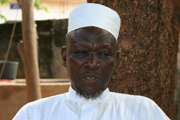Ajami in the Senegambia
by Fallou Ngom
Abba Sagna's Jóola Foñi Community
Background about Jóola Foñi
 Jóola Foñi (also known as Jola Fonyi or Diola Fogny or Kujamaat Jóola) is part of the Bak languages of the West Atlantic branch of the Niger-Congo phylum. It is primarily spoken in Casamance, Senegal, particularly at the border with The Gambia. It is also spoken in The Gambia by a substantial number of people and in parts of Guinea Bissau. It is considered to be the largest and most widely understood Jóola variety in the Senegambian sub-region (Ethnologue, 2005). Kujamaat Jóola people call themselves Kujamaat and their language Kujamutay. Kujamaat (Foñi) and Kasa are the most important dialects of the Jóola cluster of dialects spoken in Senegambia (Arnoff & Fudeman, 2005). Jóola Foñi is believed to have over 60% lexical similarity with the Jóola-Kasa variety spoken in the villages around Oussouye, Casamance. Speakers of other varieties speak Jóola-Foñi as second language (Ethnologue, 2005). The language is used in commerce, traditional religions, and in other religious services in rural Jóola Foñi communities in Casamance. Over 90% also speak Wolof, French, or Mandinka (Ethnologue, 2005). Consequently, the language has significant influence from these languages. It is used in the media in Casamance, Senegal.
Jóola Foñi (also known as Jola Fonyi or Diola Fogny or Kujamaat Jóola) is part of the Bak languages of the West Atlantic branch of the Niger-Congo phylum. It is primarily spoken in Casamance, Senegal, particularly at the border with The Gambia. It is also spoken in The Gambia by a substantial number of people and in parts of Guinea Bissau. It is considered to be the largest and most widely understood Jóola variety in the Senegambian sub-region (Ethnologue, 2005). Kujamaat Jóola people call themselves Kujamaat and their language Kujamutay. Kujamaat (Foñi) and Kasa are the most important dialects of the Jóola cluster of dialects spoken in Senegambia (Arnoff & Fudeman, 2005). Jóola Foñi is believed to have over 60% lexical similarity with the Jóola-Kasa variety spoken in the villages around Oussouye, Casamance. Speakers of other varieties speak Jóola-Foñi as second language (Ethnologue, 2005). The language is used in commerce, traditional religions, and in other religious services in rural Jóola Foñi communities in Casamance. Over 90% also speak Wolof, French, or Mandinka (Ethnologue, 2005). Consequently, the language has significant influence from these languages. It is used in the media in Casamance, Senegal.
Scroll down to see Community Image Gallery
Background information about Jóola Foñi from Casamance
Linguistic features of Jóola Foñi from Casamance
| << Previous | | 1 of 7 | | Next >> |
La 54 Transnational Road
(July 2006)Looking for a taxi on the transnational road going to Guinea Bissau called "La 54" to go meet the scholar in Santhiaba, Ziguinchor.







